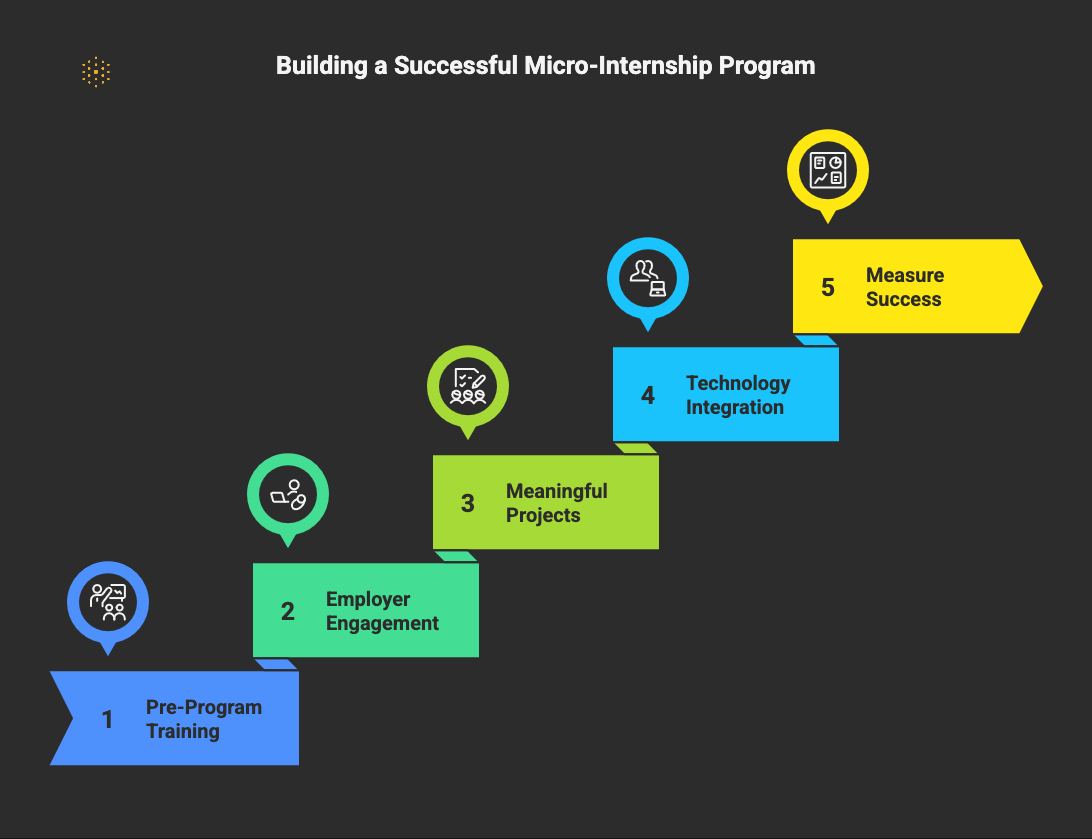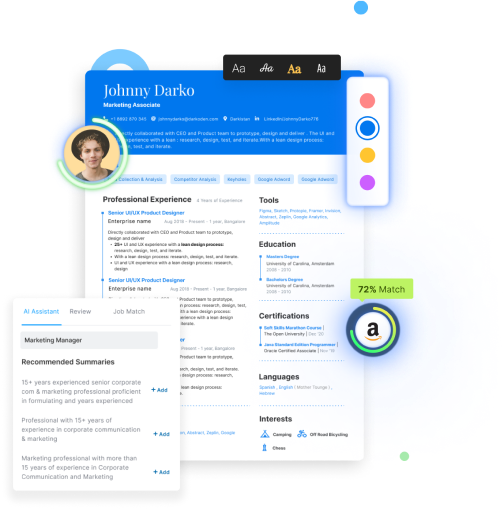How can career centers launch and scale an effective micro-internship program?
Prepare students with pre-program training, cultivate employer partners, and co-design scoped, skill-building projects. Use platforms and group coaching to scale, and track engagement, feedback, conversions, and employer satisfaction to refine.
For many first-year students, the leap from classroom to career feels huge. They’re eager to gain experience but often unsure where to start.
That’s why more universities are turning to micro-internships - short, project-based opportunities designed to give students a taste of real-world work early on.
Unlike traditional internships, these 10-40 hour projects are flexible, accessible, and designed to fit into a freshman’s busy schedule.
And the impact? Huge.
Surveys by Parker Dewey show 96% of students gain career-ready skills and 99% report a boost in confidence after completing a micro-internship.
And for many first-generation and underrepresented students, it’s often their first step toward seeing themselves in professional spaces, and that shift can change everything.
If your career center is looking to launch or expand a micro-internship program, here are 5 best practices inspired by universities leading the way.
1. Implement Pre-Program Training for Students
A cornerstone of any successful program is preparation. First-year students often lack awareness of workplace expectations and professional skills.
A 2022 study from Oklahoma Baptist University found that "most students were not aware of employers' expectations and lack career readiness competencies" at the start.
Top universities like Western Illinois University, addresses this with targeted training modules that cover:
- Resume writing and LinkedIn profile setup
- Interview preparation and professional etiquette
- Guidance on setting learning goals for a short-term project
This front-loaded support equips them with the tools to hit the ground running.
Also Read: What are some federal funding options for career centers in the US?
2. Cultivate a Strong Employer Engagement Strategy
Securing a steady supply of meaningful projects is a common challenge for career centers. To build a sustainable program, you must proactively cultivate employer participation.
Frame the program around the benefits for employers. Emphasize that micro-interns can provide skilled help with minimal overhead.
Surveys conducted by Parker Dewey show that employers see micro-internships as a “low-risk way to test out new talent before committing to a full-time hire”
Best practices for outreach include:
- Streamlining the process for hosts with project templates and clear guidelines. LSU's career center, for instance, launched weekly virtual info sessions to scale up outreach efficiently .
- Leveraging your alumni network. Alumni are often eager to mentor students. Goucher College’s program tapped exclusively into alumni hosts, which "made it easy to get these entry-level internships".
Also Read: How to improve FDS response rates?

3. Co-Design Meaningful, Skill-Building Projects
The quality of the project is critical. There's a risk that brief internships could become busywork if not carefully designed.
The goal is to avoid "assigning mundane tasks that don't contribute to their learning or the company's objectives" .
Work with employers to scope projects that have clear objectives and deliverables that are achievable in a few weeks.
A well-scoped project might be to "build a simple Python script to automate one data analysis task" rather than a vague request to "help our engineering team".
To assist hosts, universities like Ohio State advise them to "prepare meaningful tasks and projects planned out in a logical order" with a clear work plan for the intern.
Also Read: What are some career readiness activities to help students build professionalism?
4. Leverage Technology and Partnerships to Scale
Running a micro-internship program for hundreds of students can overwhelm even the most dedicated staff. Smart use of technology and partnerships is essential to scale efficiently .
Many universities partner with online platforms like Parker Dewey, which handle project postings, applications, and payments, lightening the administrative load.
These platforms can "bust... through the limitations that local or regional economies pose," giving your students access to nationwide opportunities.
Additionally, a NACE best-practice insight found that group career coaching augmented by online tools "enabled colleges to deliver career services more efficiently by allowing a smaller number of career staff to provide rich learning experiences at scale".
Also Read: How to help students build job winning portfolios?
5. Measure Success and Continuously Refine the Program
To build long-term institutional support, it's vital to track outcomes and use that data for continuous improvement.
Establish key metrics that align with your goals, such as:
- Student Engagement: Track application numbers and project completions across different demographics.
- Student Feedback: Use pre- and post-internship surveys to gauge growth in confidence and skills . Goucher College uses this method and has reported "high satisfaction rates" .
- Conversion Rates: Monitor how many micro-interns secure full summer internships or jobs with their host company . Experts suggest measuring "the rate at which [micro-internship] gigs convert into full-time job offers" or other extended opportunities.
- Employer Satisfaction: Track the return rate of host organizations and gather testimonials.
Presenting this data can make a powerful case to institutional leaders that micro-internships are a worthwhile investment.

Also Read: What are some of the best practices for setting up virtual career treks?
Wrapping Up
Micro-internships aren’t just about giving students a line on their resume, they’re about opening doors early, building confidence, and helping them step into the workplace with clarity.
For career centers, the challenge is creating these high-impact experiences at scale while keeping things personal and seamless.
That’s where Hiration partners with universities to make it easier.
From helping students fine-tune resumes and practice interviews to giving counselors collaborative ways to guide and review progress, we’re here to support career teams in delivering meaningful results, without adding to their workload.
If you’re curious how other universities like NYU Stern and Fulltron are using AI-powered career support to engage more students and elevate outcomes, we’d be happy to share what’s worked for them and explore what might work for your team too.
Frequently Asked Questions
-
What is a micro-internship?
You offer short, project-based opportunities that give students a taste of real-world work early on. These flexible, accessible experiences fit into a first-year student’s busy schedule.
-
How long does a micro-internship typically take?
You plan for 10-40 hours of work per project. The short format helps first-year students participate alongside classes.
-
How do micro-internships compare to traditional internships?
You replace lengthy roles with 10-40 hour projects that are flexible and accessible. Unlike traditional internships, these 10-40 hour projects are flexible, accessible, and designed to fit into a freshman’s busy schedule.
-
What pre-program training should you provide students?
You deliver training on resume writing and LinkedIn profile setup, interview preparation and professional etiquette, and setting learning goals for a short-term project. This front-loaded support equips them with the tools to hit the ground running.
-
How do you engage employers for micro-internships?
You frame benefits for hosts and streamline their process with project templates and clear guidelines. Employers see micro-internships as a 'low-risk way to test out new talent before committing to a full-time hire'.
-
How do you design meaningful micro-internship projects?
You co-scope clear objectives and deliverables that are achievable in a few weeks. Avoid 'assigning mundane tasks that don't contribute to their learning or the company's objectives'.
-
How can technology and partnerships help you scale a micro-internship program?
You partner with platforms that handle project postings, applications, and payments, lightening the administrative load. This can 'bust... through the limitations that local or regional economies pose,' giving your students access to nationwide opportunities.
-
How do you measure success for a micro-internship program?
You track student engagement, student feedback, conversion rates, and employer satisfaction. Use pre- and post-internship surveys to gauge growth in confidence and skills.
-
What common pitfalls should you avoid when scoping micro-internships?
You avoid 'assigning mundane tasks that don't contribute to their learning or the company's objectives'. Prepare 'meaningful tasks and projects planned out in a logical order' with a clear work plan for the intern.
-
What impact do micro-internships have on student skills and confidence?
You see strong gains in skills and confidence. Surveys by Parker Dewey show 96% of students gain career-ready skills and 99% report a boost in confidence after completing a micro-internship.



